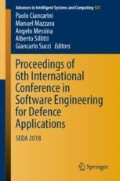Abstract
The Theory of Affordances considers the interaction between the people and their environment based on their mental models of the environment. This study analyses a software development process on the theory of affordances. The LC2EVO software has been developed in Italy. There were two onsite team groups located five kilometers apart in separate buildings who were using the agile framework in their development. The product was delivered successfully under this framework. Team members in the case study were allowed inside of their environment to arrange their workspaces. By utilizing the works of Gibson and Norman on affordances, we found that arrangement of the workspace broadly met with both ideas of affordances. The examined case study demonstrates that a collaborative process on the design of a work space inside of an agile methodology increases opportunities for collaboration and communication among team members. The design of the work space affect the application of the agile methodology. Worker’s affordances with the environment, both through their perception and interaction is fundamental to consider for the optimal and productive environment setup.
Access this chapter
Tax calculation will be finalised at checkout
Purchases are for personal use only
References
Aslam H, Brown JA, Reading E (2018) Player age and affordance theory in game design. In: King D, (ed.) Proceedings of the 19th international conference on intelligent games and simulations, GAME-ON 2018. Eurosis, pp 27–34
Barrick MR, Mount MK (1991) The big five personality dimensions and job performance: a meta-analysis. Pers Psychol 44(1):1–26
Benedicenti L, Cotugno F, Ciancarini P, Messina A, Pedrycz W, Sillitti A, Succi G (2016) Applying scrum to the army: a case study. In: Proceedings of the 38th international conference on software engineering companion. ACM, pp 725–727
Benedicenti L, Messina A, Sillitti A (2017) iAgile: mission critical military software development. In: 2017 international conference on high performance computing & simulation (HPCS). IEEE, pp 545–552
Bentham J (1995) Panopticon; or the inspection-house: Containing the idea of a new principle of construction applicable to any sort of establishment, in which persons of any description are to be kept under inspection; and in particular to penitentiary-houses, prisons, houses of industry, work-houses, poor-houses, lazarettos, manufactories, hospitals, mad-houses, and schools: With a plan of management adapted to the principle: in a series of letters, written in the year 1787, from Crecheff in white russia to a friend in England. In: Bozovic M (ed) The panopticon writing. Verso, London, pp 29–95
Boschi F, Aslam H, Brown JA (2018) Player perceptions of fairness in oddly shaped dice. In: Proceedings of the 13th international conference on the foundations of digital games, no 58. ACM
Colonese E (2016) Agile: the human factors as the weakest link in the chain. In: Proceedings of 4th international conference in software engineering for defence applications. Springer, pp 59–73
Cotugno F, Messina A (2014) Implementing scrum in the army general staff environment. In: The 3rd international conference in software engineering for defence applications-SEDA, Roma, Italy, pp 22–23
Cotugno FR, Messina A (2014) Adapting scrum to the Italian army: methods and (open) tools. In: IFIP international conference on open source systems. Springer, pp 61–69
Fertalj K, Katic M (2008) An overview of modern software development methodologies. In: 19th central european conference on information and intelligent systems
Gibson JJ (2014) The ecological approach to visual perception: classic edition. Psychology Press, New York/London
Hammond M (2010) What is an affordance and can it help us understand the use of ICT in education? Educ Inf Technol 15(3):205–217
Marr D (1982) Vision: a computational approach
Messina A, Fiore F (2016) The Italian army C2 evolution: from the current SIACCON2 land command & control system to the LC2EVO using “agile” software development methodology. In: Military communications and information systems (ICMCIS). IEEE, pp 1–8
Norman D (2013) The design of everyday things: revised and expanded edition. Basic Books (AZ), New York City
Petersen K, Wohlin C, Baca D (2009) The waterfall model in large-scale development. In: International conference on product-focused software process improvement. Springer, pp 386–400
Pittenger DJ (1993) Measuring the MBTI\(\ldots \) and coming up short. J Career Plan Employ 54(1):48–52
Royce WW (1987) Managing the development of large software systems: concepts and techniques. In: Proceedings of the 9th international conference on software engineering. IEEE Computer Society Press, pp 328–338
Sadler E, Given LM (2007) Affordance theory: a framework for graduate students’ information behavior. J Doc 63(1):115–141
Author information
Authors and Affiliations
Corresponding author
Editor information
Editors and Affiliations
Rights and permissions
Copyright information
© 2020 Springer Nature Switzerland AG
About this paper
Cite this paper
Aslam, H., Brown, J.A., Messina, A. (2020). Affordance Theory Applied to Agile Development: A Case Study of LC2EVO. In: Ciancarini, P., Mazzara, M., Messina, A., Sillitti, A., Succi, G. (eds) Proceedings of 6th International Conference in Software Engineering for Defence Applications. SEDA 2018. Advances in Intelligent Systems and Computing, vol 925. Springer, Cham. https://doi.org/10.1007/978-3-030-14687-0_3
Download citation
DOI: https://doi.org/10.1007/978-3-030-14687-0_3
Published:
Publisher Name: Springer, Cham
Print ISBN: 978-3-030-14686-3
Online ISBN: 978-3-030-14687-0
eBook Packages: Intelligent Technologies and RoboticsIntelligent Technologies and Robotics (R0)

